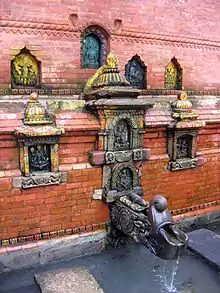
Tachhalā (Nepal Bhasa: तछला) is the eighth month in the Nepal Era calendar, the national lunar calendar of Nepal.[1] The month coincides with Jyeshtha (ज्येष्ठ) in the Hindu lunar calendar and June in the Gregorian calendar.
Tachhalā begins with the new moon and the full moon falls on the 15th of the lunar month. The month is divided into the bright and dark fortnights which are known as Tachhalā Thwa (तछला थ्व) and Tachhalā Gā (तछला गा) respectively.
Among the major festivals observed during the month, the 6th day of the bright fortnight is Sithi Nakha which is dedicated to Kumar Kartikeya, one of the two sons of Hindu deity Shiva. The special food of the festival is "wo", a lentil cake.[2] The holiday has an environmental aspect apart from its religious significance. On this day, water sources like wells, ponds and fountains are cleaned.[3]
The full moon day of Gaidu Purnimā, known as Jyā Punhi in Nepal Bhasa, is a widely celebrated holiday. For Buddhists, Jya Punhi is sacred as the day when Prince Siddhartha, the Buddha-to-be, left his home in search of enlightenment.[4]
The full moon day is also known as Panauti Punhi for the festival that takes place in Panauti, a town to the east of Kathmandu. During Panauti Jātrā, chariot processions of the deities Bhairava and Bhadrakali are held in the most important celebration here.[5]
On the 8th day of the dark fortnight, the festival of Machā Tiyā Jātrā or Trishul Jātrā ("The Procession with the Trident") is held in Deopatan in Kathmandu.[6]
Days in the month
| Thwa (थ्व) or Shukla Paksha (bright half) |
Gā (गा) or Krishna Paksha (dark half) |
|---|---|
| 1. Pāru | 1. Pāru |
| 2. Dwitiyā | 2. Dwitiyā |
| 3. Tritiyā | 3. Tritiyā |
| 4. Chauthi | 4. Chauthi |
| 5. Panchami | 5. Panchami |
| 6. Khasti | 6. Khasti |
| 7. Saptami | 7. Saptami |
| 8. Ashtami | 8. Ashtami |
| 9. Navami | 9. Navami |
| 10. Dashami | 10. Dashami |
| 11. Ekādashi | 11. Ekādashi |
| 12. Dwādashi | 12. Dwādashi |
| 13. Trayodashi | 13. Trayodashi |
| 14. Chaturdashi | 14. Charhe (चह्रे) |
| 15. Punhi (पुन्हि) | 15. Āmāi (आमाइ) |
Months of the year
| Devanagari script | Roman script | Corresponding Gregorian month | Name of Full Moon |
|---|---|---|---|
| 1. कछला | Kachhalā | November | Saki Milā Punhi, Kārtik Purnimā |
| 2. थिंला | Thinlā | December | Yomari Punhi, Dhānya Purnimā |
| 3. पोहेला | Pohelā | January | Milā Punhi, Paush Purnimā |
| 4. सिल्ला | Sillā | February | Si Punhi, Māghi Purnimā |
| 5. चिल्ला | Chillā | March | Holi Punhi, Phāgu Purnimā |
| 6. चौला | Chaulā | April | Lhuti Punhi, Bālāju Purnimā |
| 7. बछला | Bachhalā | May | Swānyā Punhi, Baisākh Purnimā |
| 8. तछला | Tachhalā | June | Jyā Punhi, Gaidu Purnimā |
| 9. दिल्ला | Dillā | July | Dillā Punhi, Guru Purnimā |
| 10. गुंला | Gunlā | August | Gun Punhi, Janāi Purnimā (Raksha Bandhan) |
| 11. ञला | Yanlā | September | Yenyā Punhi, Bhādra Purnimā |
| 12. कौला | Kaulā | October | Katin Punhi, Kojāgrat Purnimā |
References
- ↑ "Nepal Sambat gets national status". The Rising Nepal. 24 October 2008. Archived from the original on 20 October 2013. Retrieved 16 May 2014.
- ↑ Bajracharya, Munindra Ratna (30 May 2014). "Sithinakha Parva". The Rising Nepal. Kathmandu. Archived from the original on 31 May 2014. Retrieved 30 May 2014.
- ↑ Adhikari, Sharada (16 June 2011). "Sithi Nakha: Festival with a green touch". The Himalayan Times. Kathmandu. Retrieved 16 May 2014.
- ↑ Promotion of Buddhist Tourism Circuits in Selected Asian Countries; Issue 24 of ESCAP tourism review; SERIES ESCAP TOURISM REVIEW NO. 24. United Nations Publications. 2003. p. 46. ISBN 9789211203868.
- ↑ Levy, Robert Isaac (1990). "A Catalogue of Annual Events and Their Distribution throughout the Lunar Year". Mesocosm: Hinduism and the Organization of a Traditional Newar City in Nepal. University of California Press. p. 651. ISBN 9780520069114.
- ↑ Michaels, Axel (2008). "The Procession with the Trident (Trisuljatra)". Siva in Trouble: Festivals and Rituals at the Pasupatinatha Temple of Deopatan. Oxford University Press. p. 107. ISBN 9780195343021.